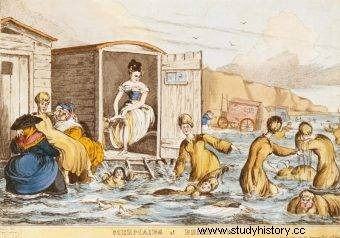Today it is difficult to imagine summer days without swimming under the open sky in the sea or lake, while sea bathing as a form of entertainment, relaxation and leisure became popular relatively recently, only a hundred years ago. Previously, people bathed only for health purposes, and not necessarily in warm water, so it was more like our sea today.
From antiquity to around the 18th century, the beaches aroused at least fear and anxiety. They feared the destructive action of the element of water, but the imagination of people was also influenced, for example, by the Bible, in which the great flood was depicted, or the mythology describing the wrath of the ocean and sea monsters inhabiting the depths. It was authentically thought that Kraken, Skylla or Charybdis could come out of the water - legendary creatures .
However, there were real threats in the form of pirates or colonizers arriving on boats. If you added abandoned shipwrecks as well as flooding and storms, you could actually say that the seaside landscape is not conducive to a comfortable rest. Only with time, the fear of entering the water was overcome, and the spooky beaches became one of the favorite places for relaxation.
Splashing for health
Over the centuries, the approach to bathing has been… different. As a rule, everyday life was limited to washing the face and hands, and the whole body was washed once in a while. Some people bathed more often - even every day, which for some time was considered extravagant, and others followed the principle that "frequent washing shortened life" . The lack of access to running water and bathrooms in the houses certainly did not help in maintaining hygiene.

It was thought that Kraken, Skylla or Charybdis could come out of the water - legendary creatures
It was only in the 18th century that people began to talk about the positive effect of bathing in natural springs on health. Seawater was thought to have remarkable healing properties, seen as a panacea for many ailments, including melancholy, tuberculosis infections, leprosy, gout, rickets, impotence, menstrual problems and the famous "hysteria" . Moreover, it was recommended not only to bathe, but also to drink sea water. The health-promoting effect of the sun and fresh air was also more appreciated. Swimming in the sea was becoming popular, but it was done only for medicinal purposes, not for pleasure. Anyway, hardly anyone could swim then, often even sailors could not boast of such skills.
The healing bath was rather like a rapid dipping in cool water - according to contemporary specialists, its temperature should not exceed a maximum of sixteen degrees. As a rule, the treatment lasted about two months. The patient was immersed every day for fifteen minutes. Winter was considered the best time of the year for this type of therapy. It is hard to call such methods pleasant and weird that they were gaining popularity.
Resorts for the rich
The first seaside health resort was established in Scarborough in Yorkshire. Its origins date back to the 17th century, but its development took place in the 30s of the 18th century, when bathing carts appeared as a result of the popularity of sea water treatments. Until the 1880s Great Britain was the only place where therapeutic baths were used . In the following decades, resorts were also built in France and Germany. In Poland, the first bathing area was established in 1803 in Brzeźno, near Gdańsk.

The first seaside health resort was established in Scarborough, Yorkshire
The development of the health resorts was influenced by the expansion of the railway infrastructure. Travel by train was becoming easier, faster and more accessible. The centers themselves were also improved - many of them hosted theatrical performances, dance evenings and concerts, thanks to which the patients could spend time together.
Stays in bathing houses, sea baths and therapeutic therapies were not the cheapest, only the aristocracy, nobility, and later the bourgeoisie used them. Poorer people did not have the financial capacity to afford such treatments . They could not quit their job for a few weeks and go to a resort. Healing pastimes were intended only for the richest. And those who had enough time.
From the cart to the water
Wealthy patients had to have the right conditions during their stay in the resort. It was inconceivable, for example, that they would parade on the beach in front of others in negligee or wet clothes that, clinging to the body, emphasized the outline of the body too much - especially women. It was considered not very decent. To ensure privacy and intimacy, bathing cars were created. It is not known exactly who and when exactly developed them, but the preserved sketches from 1735 prove that this invention was already known and used in the first half of the 18th century.

Bath wagons were like wooden houses - they had different shapes, they were square or rectangular, with two or four wheels
Bath carts were like wooden houses - they had various shapes, they were square or rectangular, with two or four wheels. They were most often pulled by horses, although it happened that they were taken care of by men. When the cart was still on the beach, you entered it up the steps, opened the door, and changed clothes inside. Then the car "drove" into the water, the door was opened again and from there you entered or jumped into the water . After finishing the bath, people returned inside, changed clothes and "left" the sea - decently and with all moral standards.
Bathing cars were found on the beaches even before the First World War, although in later years they were mainly used by the elderly, the sick and the weaker. Even Queen Victoria had a private model.
From treatment to pleasure
It was only at the beginning of the 20th century that leisure by the sea began to become a form of relaxation, a way to spend holidays. Sea baths were no longer recommended only for the sick. You were on the beach for fun. In the interwar period, the fashion for tanning appeared, so the first sunbeds were invented on which you could sunbathe comfortably. People were swam more often, which was associated with more accidents and drownings, and therefore the development of rescue services was emphasized. And better access to trains made traveling even more common, thanks to which not only the richest could go to coastal towns.
Bibliography:
- Ashenburg K., History of dirt , Warsaw 2016.
- Eco U., History of beauty , Poznań 2005.
- Przybysz M., Unusual baths, i.e. about the need to wash and not wash , Brzezia Łąka 2016.
- Sokołowska M., To wash or air? The dramatic history of hygiene from antiquity to today , Wrocław 1999.
- Vigarello G., Clean and dirty. Body hygiene from the Middle Ages to the 20th century , Warsaw 1996.
- Walton J.K., The British Seaside:Holidays and Resorts in the 20th century , Manchester 2000.
- Walton J.K., The English Seaside Resort - A Social History 1750-1914 , Leicester 1983.
